&
Herptile in General
Habitat Creation and Protection,
in Urban/Park Forests/Wetlands.
Page 2
NOTE:
This web-page
has been posted for the purpose of promoting a discussion,
an exchange of ideas/opinions and experiences. The ideas listed
below are not
presented as recommended forest/wildlife practices or management.
After my first e-mail call for help in this matter the request for aid has be further refined and more useful information has been posted for everyone to use.
This web-page was written in haste so please excuse spelling and grammatical errors.
As most of you know, where there
are Jefferson Salamanders there is the complex that has mixed chromosomes
from other species (up to four), which often makes up the greater part
of the population, which appears to be the case for us. Blue-spotted
(Ambystoma laterale) and Jefferson Salamander (Ambystoma
jeffersonianum), make the polyploid unisexual (all female), hybrids,
A. jeffersonianum complex in the Cawthra Bush. Many of the
tested, by Electrophoretic analysis, were triploid (three sets of chromosomes),
hybrids with the above genotype. One set of Blue-spotted chromosomes
and two sets of Jefferson chromosomes, so before we found a pure Jefferson
we knew that the pure species in the Cawthra Bush was the Jefferson Salamanders.
Also that it would be the males from the pure Jeffersons doing the breeding.
For ease of communicating, I will
just be referring to them all as Jeffersons, as they all depend on the
existence of Jefferson to survive and even the hybrids are mostly
Jefferson.
To E-maill me with feed back - Watcher0I0@eol.ca.
For the environmental significance
of the Cawthra Bush and a map
click
here.
The kinds of environments required;
* Upland
- well drained Forest/Terrestrial Habitat for during the
growing
season;
The kinds of environments required;
* Upland - well drained Forest/Terrestrial Habitat for during the growing season;
As explained before, it would be what Mother Nature creates but with some improvements that would make it useful to wildlife sooner, rather then later. That it would provide ongoing protection, in layers against not only predatory wildlife but also Little Boys With Buckets. The chambers created could even have a small camera installed to see what was living there.
An amphibians/herptile shelter & feeding abodes, that restock itself with food. Reasonable close to their breeding pond/s would be a good idea as the shorter the migration, the less likely it is they will die on route. These shelter & feeding abodes can also provide places for migrating Jefferson Salamanders/amphibians, protection during migration. The shelter & feeding abodes will not only feed herptiles foraging for invertebrates as food but will also create rich organic soil layers for the betterment of the forest in general and in the long term.
Not shown in diagrams is a log/s on the ground covered with piles of branches, preferable with leaves on them, as it is too hard to draw. Not only would this aid with more biomass, hide the log/s from kids and others who would want to harvest amphibian but would greatly increase the humidity in the area and likely for more then one year. This is the cheapest and very effective way, in fact, Mother nature's way to create an amphibian/herptile shelter & feeding abodes. Using fresh cut branches with leaves is best and adding piles of leaf litter beside the log is great too. This helps keep the moisture in the created habitat, it also helps kick off the food chain. Adding dirt, good rich dirt helps too. If it is from somewhere else in the forest that is best as there are concerns about importing seeds, that could contain invader species. Adding compost is a good idea so long as it is free of contamination's, including foreign seeds.
Piles of leave litter and branches in urban/park areas can be a problem, in terms of a fire hazard. In time, the top layer could dry out enough to be set on fire. Or people could try driving trucks in for firewood. The use of dirt to cover is a good idea and provides a chance to seed wild flowers. Something the public will enjoy the sight of. A pile of branches is a hard thing to cover. The spaces between the branches can take a lot of dirt to fill up. Again the use of old construction material can help. Old sheets of wood can used to cover the pile before the dirt and the spaces below are great for habitat. In time they may start to show through and be unsightly, just cover them with more dirt, a forest will in time recycle wood completely. So long as the wood has no harmful chemicals.
The use of chain link fence on the ground. Chain link fence can be cut up and lay on top of the piles of logs and branches on the ground, secure to the ground with stakes and covered with more branches to hid the fence. A mat or large square, can be created by attaching the tops and bottoms together. It has to be done so people would actually have to cut through the wire not lift apart unattached sections. Logs can be held to the ground with stakes through them and the chain link fence. Covering the chain link fence with a layer of dirt and/or branches to hide it should be done. The reason for this is simple and common to all urban forests/parks. The Cawthra Bush is a public park and the public as access to almost all parts of it so it is plagued by people easily turning over stones and logs and either dropping them back on amphibians or leaving the stone/log flipped over, as they collect/remove wildlife from the forest. If it is made very difficult to reach the herptiles, then they will likely heard the efforts being made to dig down to them and try to escape. The spaces created in the rubble and piles of branches will make many openings for escape. Plus it will be a major undertaking for those trying to dig down, this will increases the chances they will be seen and stopped. If we are to create more habitat it must also protect them or populations will not increase. Old chain link fence is fairly easy to get as well for a city. Other suggestions are welcome.
The following ideas use mostly the same elements in different combinations. The controlling factors would cost, available material, labour (volunteers?) and the willingness of the land owner to help the cause.
1).

As a City cuts trees down almost
every day the use of large logs is not a problem. By cutting them
in haft, length ways this greatly increases the surface area in contact
with the ground, what bugs and animals can hide under as well as the amount
of water that can be quickly drawn up to speed the rotting process. As
cutting on tree creates two logs it doubles the effect and habitat created.
The bigger the trees the better, not just in terms of the nutrients added
to the soil but also the length of time an effective and protected habitat
will exist.
2).

The second most important element
is protecting the habitat and those living in it. In urban parks
people (L.B.W.B.), are the amphibians greatest predators. So a real
effort has to be made to keep in place what is created. In Cawthra
the City is talking about fencing in a section (for some time now).
The first line of defence should to fence in large areas but fences in
themselves can not be relied upon alone. Whatever is created needs
its own separate protection. The use of old chain link fence laid
on top of logs or hibernaculum is a must. The lengths of fence should
be tied together to create a mat that can not be easily gotten under.
Staked to the ground and to any logs being used. Then covered in
dirt not just to create an environment for vegetation and retain moisture
but to hide the whole affair. This make the whole affair more nature
looking to those catching sight of it and less likely to attracted the
attention of those out to collect wildlife.
3).
![]()
By staking the logs together it
becomes even hard to get under them. A mat effect can be used to
create a habitat over a larger area. The large the logs the better.
4).

The best kind of stake to use is
one that holds as much of the log as possible. A U shaped one, maybe
have to drive in two stakes and weld the top on it. So as the log
breaks down, it will still be hard to roll them over or move them from
its location.
5).

In some cases cutting the log in
haft is impractical. As the cutting off a slice, length wise of the
log is very important to accelerate the break down of the log, even if
it is not a full haft, it should be done.
6).
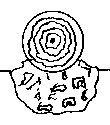
For a little extra money a pit can
be dug the length of the log (or just part of the length), and it set on
top of a pile of rubble. The material normally used in creating a
hibernaculum can be used to fill the pit and maybe some wood chips or other
food to help create layers of organic rich soil. Large concrete blocks
with their bottoms knocked off create great arches and spaces in these
piles that will last for many years. Unwaxed heavy paper tubes can
be set into the rubble, to provide direct access to the rubble or a chamber.
7).

In terms of low cost a single large
log can be put to good use by just laying it on the ground, piling rubble
beside it, covering it with dirt and/or branches. Fencing over it
can also be done.
Something to consider.
One of the old-growth features is a pit, created from a large tree falling
over, (soon to become a mound), and is at the end (usually the lager end),
of fallen tree. These pits will usually have pools of water in them
during the spring and maybe the summer. For breeding amphibians living
under a fallen tree and having a pond at one end would be heaven.
Not just for breeding (next to no migration trip), but for helping to keep
the whole areas moist. Who knows, do they go for a swim every now
and then? I wonder, have seen adult Jeffersons in the breeding pond
months after they should have left it and they are good swimmers.
For best results an amphibian/herptile shelter & feeding abode can
be built either with one end facing an existing pond or dig a pond at one
end. This kind of micro habitat will benefit many plants as well.
8).
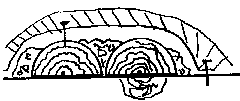
The more logs added and rubble the
better. Fence over top with dirt is best. A small hole here
and there can be dug under the logs or a trench to greatly increase the
effectiveness of this effort.
9).
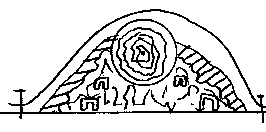
With a single large log, a bed of
rumble, dirt over top and fence. For a cheap way that doesn't require
digging into the ground.
10).
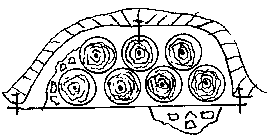
Smaller logs in a mat or raft can
used but best in a pile. A flat top for easy of piling the dirt and
plants to grow would be recommended. Fence over top with dirt is
best. A small hole here and there can be dug under the logs or a
trench to greatly increase the effectiveness of this effort. In this
case a greater effort needs to make sure they a held in place by some means
as they are easier to move. Adding rubble between the lays of logs
aids wildlife movement in the pile. Wood chips will also speed up
this habitat becoming a food source.
11).

Large paper tubes, the kind used
for construction of highway overpasses, un-waxed or waxed (for longer decay
time but must not be a wax harmful to the environment), can be stuffed
with wood chips (or a mixture of dirt and compost), that has been or has
not been sterilized, with holes into them where they touch the ground to
create easy entrance for bugs and wildlife. Fast food joint for bugs
and those to follow. This set up will have fast results in terms
of creating a food source but will also rot faster then a normal log.
The tube would have to be very tightly stuffed with wood chips to work
best. It would likely work best if tube is haft way into the ground
with the thought that once the tube had lost most of its shape a large
log can be set on top of it. Again covering it would be a must as
it would look so unnatural.
12).
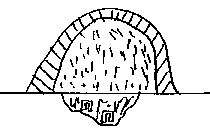
A pile of wood chips by itself on
the ground or over top of rubble can work. In both cases, should
be cover with dirt and fence, not just to make it easier to look at but
people have been known to remove piles of wood chips for their own use.
A long pile of wood chips like the stem of a large tree on the ground can
also be done.
A cord of wood put over a pit filled with rubble can also be done. As the years pass and the logs rot, more can be added. Or short lengths of logs can be lay on the sides of the pit, to help draw moisture out of the ground and keep it in the pit area.
Maybe even try large logs about 3 feet long stood on end.
13).
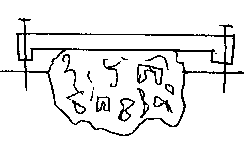
A cap for an amphibians/herptile
shelter & feeding station or hibernaculum of concrete, staked to the
ground and then covered with dirt is the best way to ensure that in urban/park
areas people don't try and dig up herptiles. Especially, any rare,
threatened or endangered species.
* Breeding ponds.
The Cawthra Bush use to have more standing water then it currently does, due to surrounding urban development and a watermain that was recently installed down its east side, draining off water by way of the french drain effect. Looking for references about this as well. There are few to note how a pipe line beside a wetlands can help dry out the wetlands.
The water table can raise in the winter months as much as 10 feet close to the breeding pond. An old estate well is used to measure the water table. An ephemeral wetlands and running stream are formed in early spring. Much less now, due to watermain pipe. Our local conservation body has come out in our support in the past with a common idea, make more ponds to ensure the survival of amphibians.
January 20, 1998
From Robert Morris - Credit Valley
Conservation, Biologist
To the City of Mississauga
...
I am most concerned about the hydrological impacts, the need for further investigations as recommended and the opportunities for rehabilitation. Damming flows, and stormwater treatment may represent only a few of the options available for rehabilitation. Clay plugs or other groundwater barriers and the importation of water from other sources (e.g. neighbouring rooftops) to raise water tables are just a few other ideas to consider.
Pond enlargement or creation should not be negatively viewed as it relates to mosquitos. Large populations likely occur from widespread wet areas that are usually seasonal in nature. More permanent ponds would provide relatively less habitat and can also harbour more predators of mosquito larvae such as salamander larva. Stickleback fish that are very adaptable could also be introduced. It should be recognized that such insects are the base of the food chain and if the goals and objectives of this plan in strengthening the native ecosystem of this area is to be achieved, mosquitos will be an integral component.
...
However, City staff just said that Dr. Bogart says adding Stickleback to the pond would mean they would eat the salamander larvae and that was the end of that whole effort. By now you should be getting the feeling that City staff don't care how unreasonable they appear when it comes to telling us to get lost and take our ideas with us. It would be nice if the City would at least give permission for us to do the work, that they refused to. There are a number of areas that are seasonally wet, that used to have standing water for most, if not the year round, that could be enhanced or restored, so they again were ponds for amphibians.
There a couple issues that we need some feed back on. In the last year our only Jefferson Salamander pond has suddenly become over grown with Duck weed and what appears to be an aquatic plant, a Wort, maybe. So our breeding pond has in last two years, gone from having no plants to being cover with duck weed and the bottom filling up with an aquatic plant making it very hard to swim around in. The whole existing ecology of the pond is changing. Does any one out there have any experience with this kind of plant invasion? Will affect the Jefferson's breeding?
Another
question is how to deal with local residents who don't like mosquitoes and
want the forest drained out? Add to it the fear that mosquito's spread
all kinds of disease, even the City tells volunteers who show up to help
to beware of West Nile virus. How do we get people to put up living
close to a wetlands?
* Hibernaculums.
Looking for people who have done so for herptiles who would not mind writing about having done so, giving some details about how they did so and the cost. If anyone has done so for amphibians especially mole salamanders, we really need to hear form you and how it turned out. Success or failure let us know.
The City of Mississauga staff say you can't built hibernaculums that will work unless they have a south facing exposure, for the sun to warm them. As we have to built in a mature forest there is none of that. But as there are snakes and salamanders here, they are somehow getting by. Anyone built a hibernaculum in a forest and have it work?
Anyone out
there have an experiences with mole salamanders sharing the same dens,
during the growing season or winter?
* The Urban Amphibian Bunker.
The ideas with logs, branches, etc., that have a layer of protection such as a chain fence over top of them are bunkers of a sort. The idea already expressed is a safety haven for amphibians/reptiles in an urban/park setting from all but the most determine collectors or disturbers of their habitat.
Concrete forms made to look like stones but with space enough for herptiles underneath and staked to the ground can be used in the fenced areas or outside them. It could be like a small underground box complex with levels in it. Could be a small bit of rubble underneath. Could be used as herptiles travel the forest floor but not something the LBWB can turn over at will.
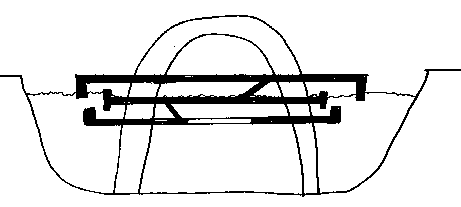
This next idea takes the protection a step further. As it is just an idea and hard to draw I have not spent much time trying to drawing it, best to try and explain it. This would be placed in ponds so amphibians can hide when LBWB or anyone comes to capture them. It would have layers with holes and ramps so they can move up of down and not get stuck under one level. So that with the raising and falling of water level there would still a way in or out, at water level. The ends of the levels would have lips so that people can not reach inside or poke sticks in. Maybe, use short alternating tubes or tubes with bends in them. It would have to be built to withstand the environment so it would be costly. But it would sure to be a conversation piece. The top levels should have large flat spots for plantings to help it blend in. Having a contest for art and/or engineering students to design it would likely be a good idea. It can help protect water breeding salamander, toads and frogs in general, year round. It would be there when park staff are not.
PLEEASSE SIGN OUR PETITION
It will make a difference!
Home page - Main Table of Contents - Back a page - Back to Top